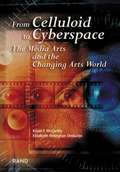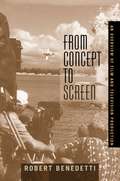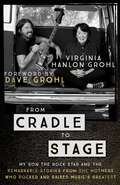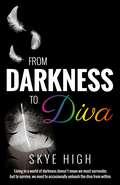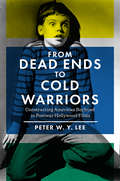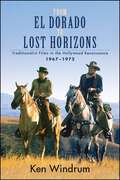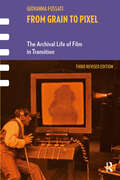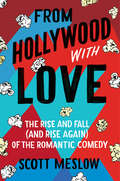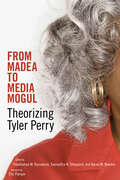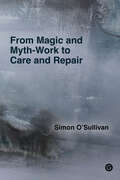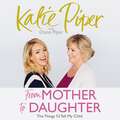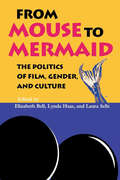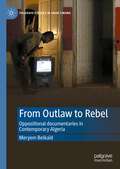- Table View
- List View
From Celluloid to Cyberspace
by Kevin F. Mccarthy Elizabeth Heneghan OndaatjeCurrent knowledge of the operation of the arts world and its underlying dynamics is limited, especially with regard to the media arts--art that is produced using or combining film, video, and computers. The authors examine the organizational features of the media arts, placing them in the context of the broader arts environment and identifying the major challenges they face. They take a structural point of view, discussing audiences, media artists as a group, arts organizations, and funding for the media arts.
From Concept to Screen: An Overview of Film and Television Production
by Robert L. BenedettiWritten by an Emmy-award-winning producer and director, this book focuses on the underlying principles of film and television production, emphasizing the creative rather than the technical aspects. The book describes how a film is created - from conception to screen - and provides a comprehensive overview of the entire production process. Not intended as a "how-to" book, this book presents only a limited amount of detailed technical information. Instead, it emphasizes the underlying principles and processes of primarily four kinds of films: feature, independently financed, made-for-network-television, and made-for-cable movies. For anyone interested in writing, directing, producing or acting for film/TV.
From Cradle to Stage: Stories from the Mothers Who Rocked and Raised Rock Stars
by Virginia Hanlon GrohlFrom Cradle to Stage shares stories and exclusive photos featuring mothers of rock icons, the icons themselves, and their Behind the Music-style relationshipsWhile the Grohl family had always been musical-the family sang together on long car trips, harmonizing to Motown and David Bowie, Virginia Grohl never expected her son to become a musician, let alone a rock star. But when she saw him perform in front of thousands of screaming fans for the first time, she knew that stardom was meant to be for her son. And as Virginia watched her son's star rise, she often wondered about the other mothers who raised children who became rock stars. Were they as surprised as she was about their children's fame? Did they worry about their children's livelihood and well-being in an industry fraught with drugs and other dangers? Did they encourage their children's passions despite the odds against success, or attempt to dissuade them from their grandiose dreams? Do they remind their kids to pack a warm coat when they go on tour?Virginia decided to seek out other celebrity mothers to ask these questions, and so began a two-year odyssey in which she interviewed such women as Verna Griffin, Dr. Dre's mother; Marianne Stipe, Michael Stipe of REM's mother; Janis Winehouse, Amy Winehouse's mother; Patsy Noah, Adam Levine's mother; Donna Haim, mother of the Haim sisters; Hester Diamond, Mike D of The Beastie Boys' mother.With exclusive family photographs and a foreword by Dave Grohl, From Cradle to Stage will appeal to mothers and music fans everywhere.(P)2017 Hachette Audio
From Cradle to Stage: Stories from the Mothers Who Rocked and Raised Rock Stars
by Virginia Hanlon GrohlVirginia Grohl, mother of Dave Grohl, had not seen any of it coming. Not the arenas of screaming fans, not Nirvana or the Foo Fighters, not the induction into the Rock and Roll Hall of Fame, and certainly not her son, Dave, performing with Sir Paul McCartney at The White House. Theirs had always been a life full of music - the Grohl family sang together on long car trips, harmonising to Motown and David Bowie - yet Virginia never expected her son to become a musician. But when Virginia saw Nirvana play for the first time to crazed applause from thousands of screaming fans, she knew nothing would ever be the same. She was the mother of a rock star.And as Virginia watched her son's star rise, she often wondered about the other mothers who raised sons and daughters who became rock stars. Were they as surprised as she was about their children's fame? Virginia often wondered about the mystical force that urges some of us to listen, to play, to surround ourselves with music. She wanted to talk about it with the other mothers whose sons and daughters were sharing stages with Dave, and she decided to seek them out wherever they were. So began a two-year odyssey, where she had conversations with such women from all over the world as Verna Griffin, Dr Dre's mother, Carolyn Williams, Pharell William's mother, Janis Winehouse, Amy Winehouse's mother, Patsy Noah, Adam Levine's mother, Donna Haim, mother to the Haim sisters and Hester Diamond, Mike D of The Beastie Boys' mother, to name just a few. From Cradle to Stage will appeal to mothers everywhere, but particularly to those with children who march (or play) to the beat of their own drum; and it's for those children who have their mothers to thank for everything. For music lovers and rock fans, it's the ultimate backstage pass-for anyone who has wondered what it's like to be on the inside...looking out at a packed arena. Featuring a foreword by Dave Grohl and exclusive family photographs, interviews are interwoven with the Grohl family story and the resultant book is a very intimate portrait of what makes a rock star.
From Darkness to Diva
by Skye HighBeyond the stereotypical expectation of glitter and sequins, comes a personal and inspirational journey of overcoming fear, rejection and insecurity. This story isn't solely about a drag-queen, but rather, it's a journey of real life experiences which many of us have faced throughout life, written by a gay man who happens to be a drag-queen. It's a story which is relevant in today's society, regardless of one's own sexuality.This book was written to bring inspiration and hope to anyone who may need positive affirmation to love the life they live, or for anyone who needs to understand first-hand what it can be like to fight, a sometimes losing battle, for self acceptance. Whoever the reader, it shows that it is possible to overcome extreme adversity and survive those horrendous experiences which seem determined to destroy us."In a world where society dictates 'right' from 'wrong', a young boy struggles with the pressure of living up to the expectations of others. Desperately seeking acceptance and finding only rejection, he is isolated and on the brink of despair. There seems to be no escape from the years of relentless school-ground bullying and victimization he suffers, which at times, is almost too much to bear. He feels as though his spirit has been crushed, but this young scared boy still harbours a burning desire to break free and be true to himself.Later in life, a tremendous gut-wrenching loss would set him on another course, and a journey of true self-discovery. Armed with the knowledge of his past experiences, his eyes are opened to a wonderland of pleasures, and through determination and sacrifice, he leaves a life of secrecy and sexual defiance behind him. Discovering the world of drag, he becomes more of a man than he thought he would be, and more of a woman than he thought he ever could be. From Darkness to Diva is an empowering tale of overcoming fear and insecurity, with an uplifting message of triumph."
From Dead Ends to Cold Warriors: Constructing American Boyhood in Postwar Hollywood Films
by Peter W.Y. LeeAfter World War II, studies examining youth culture on the silver screen start with James Dean. But the angst that Dean symbolized—anxieties over parents, the “Establishment,” and the expectations of future citizen-soldiers—long predated Rebels without a Cause. Historians have largely overlooked how the Great Depression and World War II impacted and shaped the Cold War, and youth contributed to the national ideologies of family and freedom. From Dead Ends to Cold Warriors explores this gap by connecting facets of boyhood as represented in American film from the 1930s to the postwar years. From the Andy Hardy series to pictures such as The Search, Intruder in the Dust, and The Gunfighter, boy characters addressed larger concerns over the dysfunctional family unit, militarism, the “race question,” and the international scene as the Korean War began. Navigating the political, social, and economic milieus inside and outside of Hollywood, Peter W.Y. Lee demonstrates that continuities from the 1930s influenced the unique postwar moment, coalescing into anticommunism and the Cold War.
From Eileen Chang to Ang Lee: Lust/Caution (Academia Sinica on East Asia)
by Whitney Crothers Dilley Peng Hsiao-YenIn 2007, Ang Lee made an espionage thriller based on the short story "Lust, Caution" by Eileen Chang, China’s most famous female author of the twentieth century. The release of the film became a trigger for heated debates on issues of national identity and political loyalty, and brought unexpectedly harsh criticism from China, where Ang Lee was labelled a traitor in scathing internet critiques, whilst the film's leading actress Tang Wei was banned from appearing on screen for two years. This book analyses Ang Lee’s art of film adaptation through the lens of modern literary and film theory, as well as featuring detailed readings and analyses of different dialogues and scenes, directorial and authorial decisions and intentions, while at the same time confronting the intense political debates resulting from the film’s subject matter. The theories of Freud, Lacan, Deleuze, Bataille and others are used to identify and clarify issues raised by the film related to gender, sexuality, eroticism, power, manipulation, and betrayal; the themes of lust and caution are dealt with in conjunction with the controversial issues of contemporary political consciousness concerning patriotism, and the Sino-Japanese War complicated by divided historical experiences and cross-Taiwan Strait relationships. The contributors to this volume cover translation and adaptation, loyalty and betrayal, collaboration and manipulation, playing roles and performativity, whilst at the same time intertwining these with issues of national identity, political loyalty, collective memory, and gender. As such, the book will appeal to students and scholars of Chinese and Asian cinema and literature, as well as those interested in modern Chinese history and cultural studies.
From El Dorado to Lost Horizons: Traditionalist Films in the Hollywood Renaissance, 1967-1972 (SUNY series, Horizons of Cinema)
by Ken WindrumThe era known as the Hollywood Renaissance is celebrated as a time when revolutionary movies broke all the rules of the previous "classical" era as part of the ferment of the late 1960s and early 1970s. Yet many films during this era did not overtly smash the system but provided more traditional entertainment, based on popular genres, for a wider audience than the youth culture who flocked to more transgressive fare. Ken Windrum focuses on four genres of traditionalist movies—big-budget musicals, war spectacles, "naughty" sex comedies, and Westerns. From El Dorado to Lost Horizons shows how even seemingly innocuous, family-oriented films still participated in the progressive aspects of the time while also holding a conservative point of view. Windrum analyzes representations of issues including gender roles, marriage, sexuality, civil rights, and Cold War foreign policy, revealing how these films dealt with changing times and reflected both status quo positions and new attitudes. He also examines how the movies continued or deviated from classical principles of structure and style. Windrum provides a counter-history of the Hollywood Renaissance by focusing on a group of important films that have nevertheless been neglected in scholarly accounts.
From Fairy Tale to Film Screenplay: Working with Plot Genotypes
by Terence Patrick MurphyIn Screenplay: The Foundations of Screenwriting (1979), Syd Field first popularized the Three-Act Paradigm of Setup, Confrontation and Resolution for conceptualizing and creating the Hollywood screenplay. For Field, the budding screenwriter needs a clear screenplay structure, one which includes two well-crafted plot points, the first at the end of Act I, the second at the end of Act II. By focusing on the importance of the four essentials of beginning and end, and the two pivotal plot points, Field did the Hollywood film industry an enormous service. Nonetheless, although he handles the issue of overall structure expertly, Field falls down when offering the screenwriter advice on how to successfully build each of the three individual Acts. This is because Field did not recognize the importance of another layer of analysis that underpins the existence of plot points. This is the level of the plot genotype.This book will offer you a richer theory of plot structure than the one Field outlines. It will do this not by contradicting anything Field has to say about the Hollywood paradigm, but by complementing it with a deeper level of analysis. Plot genotypes are the compositional schemas of particular stories. They are sets of instructions, written in the language of the plot function, for executing particular plots. This book outlines the plot genotypes for The Frog Prince, The Robber Bridegroom, Puss-in-Boots, and Little Red Riding Hood and then shows how these genotypes provide the underpinnings for the film screenplays of Pretty Woman, Wrong Turn, The Mask, and Psycho. By means of a detailed study of these four Hollywood screenplays, you will be able to offer a much richer description of what is going on at any particular point in a screenplay. In this way, you will become much sharper at understanding how screenplays work. And you will become much better at learning how to write coherent screenplays yourself.
From Fairy Tale to Film Screenplay: Working with Plot Genotypes
by Terence Patrick MurphyIn Screenplay: The Foundations of Screenwriting (1979), Syd Field first popularized the Three-Act Paradigm of Setup, Confrontation and Resolution for conceptualizing and creating the Hollywood screenplay. For Field, the budding screenwriter needs a clear screenplay structure, one which includes two well-crafted plot points, the first at the end of Act I, the second at the end of Act II. By focusing on the importance of the four essentials of beginning and end, and the two pivotal plot points, Field did the Hollywood film industry an enormous service. Nonetheless, although he handles the issue of overall structure expertly, Field falls down when offering the screenwriter advice on how to successfully build each of the three individual Acts. This is because Field did not recognize the importance of another layer of analysis that underpins the existence of plot points. This is the level of the plot genotype.This book will offer you a richer theory of plot structure than the one Field outlines. It will do this not by contradicting anything Field has to say about the Hollywood paradigm, but by complementing it with a deeper level of analysis. Plot genotypes are the compositional schemas of particular stories. They are sets of instructions, written in the language of the plot function, for executing particular plots. This book outlines the plot genotypes for The Frog Prince, The Robber Bridegroom, Puss-in-Boots, and Little Red Riding Hood and then shows how these genotypes provide the underpinnings for the film screenplays of Pretty Woman, Wrong Turn, The Mask, and Psycho. By means of a detailed study of these four Hollywood screenplays, you will be able to offer a much richer description of what is going on at any particular point in a screenplay. In this way, you will become much sharper at understanding how screenplays work. And you will become much better at learning how to write coherent screenplays yourself.
From Grain to Pixel: The Archival Life of Film in Transition, Third Revised Edition (Framing Film)
by Giovanna FossatiIn From Grain to Pixel, Giovanna Fossati analyzes the transition from analog to digital film and its profound effects on filmmaking and film archiving. Reflecting on the theoretical conceptualization of the medium itself, Fossati poses significant questions about the status of physical film and the practice of its archival preservation, restoration, and presentation. From Grain to Pixel attempts to bridge the fields of film archiving and academic research by addressing the discourse on film's ontology and analyzing how different interpretations of what film is affect the role and practices of film archives. By proposing a novel theorization of film archival practice, Fossati aims to stimulate a renewed dialogue between film scholars and film archivists. Almost a decade after its first publication, this revised edition covers the latest developments in the field. Besides a new general introduction, a new conclusion, and extensive updates to each chapter, a novel theoretical framework and an additional case study have been included.
From Havana to Hollywood: Slave Resistance in the Cinematic Imaginary (SUNY series, Afro-Latinx Futures)
by Philip KaisaryFrom Havana to Hollywood examines the presence or absence of Black resistance to slavery in feature films produced in either Havana or Hollywood—including Gillo Pontecorvo's Burn!, neglected masterpieces by Cuban auteurs Tomás Gutiérrez Alea and Sergio Giral, and Steve McQueen's Oscar-winning 12 Years a Slave. Philip Kaisary argues that, with rare exceptions, the representation of Black agency in Hollywood has always been, and remains, taboo. Contrastingly, Cuban cinema foregrounds Black agency, challenging the ways in which slavery has been misremembered and misunderstood in North America and Europe. With powerful, richly theorized readings, the book shows how Cuban cinema especially recreates the past to fuel visions of liberation and asks how the medium of film might contribute to a renewal of emancipatory politics today.
From Here to the Great Unknown: A Memoir
by Lisa Marie Presley Riley Keough#1 NATIONAL BESTSELLER • NEW YORK TIMES BESTSELLER • OPRAH&’S BOOK CLUB PICK • Born to an American myth and raised in the wilds of Graceland, Lisa Marie Presley tells her whole story for the first time in this raw, riveting, one-of-a-kind memoir faithfully completed by her daughter, Riley Keough. A PEOPLE BEST BOOK OF THE YEARIn 2022, Lisa Marie Presley asked her daughter to help finally finish her long-gestating memoir. A month later, Lisa Marie was dead, and the world would never know her story in her own words, never know the passionate, joyful, caring, and complicated woman that Riley loved and now grieved. Riley got the tapes that her mother had recorded for the book, lay in her bed, and listened as Lisa Marie told story after story about smashing golf carts together in the yards of Graceland, about the unconditional love she felt from her father, about being upstairs, just the two of them. About getting dragged screaming out of the bathroom as she ran toward his body on the floor. About living in Los Angeles with her mother, getting sent to school after school, always kicked out, always in trouble. About her singular, lifelong relationship with Danny Keough, about being married to Michael Jackson, what they had in common. About motherhood. About deep addiction. About ever-present grief. Riley knew she had to fulfill her mother&’s wish to reveal these memories, incandescent and painful, to the world. To make her mother known. This extraordinary book is written in both Lisa Marie&’s and Riley&’s voices, a mother and daughter communicating—from this world to the one beyond—as they try to heal each other. Profoundly moving and deeply revealing, From Here to the Great Unknown is a book like no other—the last words of the only child of an American icon.
From Hollywood with Love: The Rise and Fall (and Rise Again) of the Romantic Comedy
by Scott MeslowAn in-depth celebration of the romantic comedy’s modern golden era and its role in our culture, tracking the genre from its heyday in the ’80s and the ’90s, its unfortunate decline in the 2000s, and its explosive reemergence in the age of streaming, featuring exclusive interviews with the directors, writers, and stars of the iconic films that defined the genre.No Hollywood genre has been more misunderstood—or more unfairly under-appreciated—than the romantic comedy. Funny, charming, and reliably crowd-pleasing, rom-coms were the essential backbone of the Hollywood landscape, launching the careers of many of Hollywood’s most talented actors and filmmakers, such as Julia Roberts and Matthew McConaughey, and providing many of the yet limited creative opportunities women had in Hollywood. But despite—or perhaps because of—all that, the rom-com has routinely been overlooked by the Academy Awards or snobbishly dismissed by critics. In From Hollywood with Love, culture writer and GQ contributor Scott Meslow seeks to right this wrong, celebrating and analyzing rom-coms with the appreciative, insightful critical lens they’ve always deserved. Beginning with the golden era of the romantic comedy—spanning from the late ’80s to the mid-’00s with the breakthrough of films such as When Harry Met Sally—to the rise of streaming and the long-overdue push for diversity setting the course for films such as the groundbreaking, franchise-spawning Crazy Rich Asians, Meslow examines the evolution of the genre through its many iterations, from its establishment of new tropes, the Austen and Shakespeare rewrites, the many love triangles, and even the occasional brave decision to do away with the happily ever after. Featuring original black-and-white sketches of iconic movie scenes and exclusive interviews with the actors and filmmakers behind our most beloved rom-coms, From Hollywood with Love constructs oral histories of our most celebrated romantic comedies, for an informed and entertaining look at Hollywood’s beloved yet most under-appreciated genre.
From Light to Byte: Toward an Ethics of Digital Cinema
by Markos HadjioannouCinema has been undergoing a profound technological shift: celluloid film is being replaced by digital media in the production, distribution, and reception of moving images. Concerned with the debate surrounding digital cinema&’s ontology and the interrelationship between cinema cultures, From Light to Byte investigates the very idea of change as it is expressed in the current technological transition. Markos Hadjioannou asks what is different in the way digital movies depict the world and engage with the individual and how we might best address the issue of technological shift within media archaeologies.Hadjioannou turns to the technical basis of the image as his first point of departure, considering the creative and perceptual activities of moviemakers and viewers. Grounded in film history, film theory, and philosophy, he explores how the digital configures its engagement with reality and the individual while simultaneously replaying and destabilizing celluloid&’s own structures. He observes that, where film&’s photographic foundation encourages an existential association between individual and reality, digital representations are graphic renditions of mathematical codes whose causal relations are more difficult to trace.Throughout this work Hadjioannou examines how the two technologies set themselves up with reference to reality, physicality, spatiality, and temporality, and he concludes that the question concerning digital cinema is ultimately one of ethical implications—a question, that is, of the individual&’s ability to respond to the image of the world.
From Madea to Media Mogul: Theorizing Tyler Perry
by Karen N. Sheppard TreaAndrea M. Russworm Samantha M. BowdreContributions by Leah Aldridge, Karen M. Bowdre, Aymar Jean Christian, Keith Corson, Rachel Jessica Daniel, Artel Great, Brandeise Monk-Payton, Miriam J. Petty, Eric Pierson, Paul N. Reinsch, TreaAndrea M. Russworm, Rashida Z. Shaw, Samantha N. Sheppard, Ben Raphael Sher, and Khadijah Costley WhiteFor over a decade, Tyler Perry has been a lightning rod for both criticism and praise. To some he is most widely known for his drag performances as Madea, a self-proclaimed "mad black woman," not afraid to brandish a gun or a scalding pot of grits. But to others who watch the film industry, he is the businessman who by age thirty-six had sold more than $100 million in tickets, $30 million in videos, $20 million in merchandise, and was producing 300 projects each year viewed by 35,000 every week.Is the commercially successful African American actor, director, screenwriter, playwright, and producer "malt liquor for the masses," an "embarrassment to the race!," or is he a genius who has directed the most culturally significant American melodramas since Douglas Sirk? Are his films and television shows even melodramas, or are they conservative Christian diatribes, cheeky camp, or social satires? Do Perry's flattened narratives and character tropes irresponsibly collapse important social discourses into one-dimensional tales that affirm the notion of a "post-racial" society?In light of these debates, From Madea to Media Mogul makes the argument that Tyler Perry must be understood as a figure at the nexus of converging factors, cultural events, and historical traditions. Contributors demonstrate how a critical engagement with Perry's work and media practices highlights a need for studies to grapple with developing theories and methods on disreputable media. These essays challenge value-judgment criticisms and offer new insights on the industrial and formal qualities of Perry's work.
From Madman to Crime Fighter: The Scientist in Western Culture
by Roslynn D. HaynesA study of the scientist in Western culture, from medieval images of alchemists to present-day depictions of cyberpunks and genetic engineers.They were mad, of course. Or evil. Or godless, amoral, arrogant, impersonal, and inhuman. At best, they were well intentioned but blind to the dangers of forces they barely controlled. They were Faust, Frankenstein, Jekyll, Moreau, Caligari, Strangelove—the scientists of film and fiction, cultural archetypes that reflected ancient fears of tampering with the unknown or unleashing the little-understood powers of nature.In From Madman to Crime Fighter, Roslynn D. Haynes analyzes stereotypical characters—including the mad scientist, the cold-blooded pursuer of knowledge, the intrepid pathbreaker, and the bumbling fool—that, from medieval times to the present day, have been used to depict the scientist in Western literature and film. She also describes more realistically drawn scientists, characters who are conscious of their public responsibility to expose dangers from pollution and climate change yet fearful of being accused of lacking evidence.Drawing on examples from Britain, America, Germany, France, Russia, and elsewhere, Haynes explores the persistent folklore of mad doctors of science and its relation to popular fears of a depersonalized, male-dominated, and socially irresponsible pursuit of knowledge for its own sake. She concludes that today’s public response to science and scientists—much of it negative—is best understood by recognizing the importance of such cultural archetypes and their significance as myth. From Madman to Crime Fighter is the most comprehensive study of the image of the scientist in Western literature and film.
From Magic and Myth-Work to Care and Repair
by Simon O'SullivanThe practices of magic and contemporary myth-making in relation to landscape, performance, and writing.From Magic and Myth-Work to Care and Repair is a two-part book bringing together fourteen essays broadly concerned with the &“fiction of the self&” and with practices and explorations beyond that fiction. Each part of the book approaches this theme from a different angle.The first part, entitled &“On Magic and Myth-Work,&” deals with practices of transformation and with contemporary myth-making in relation to landscape, performance, and writing. The second part, &“On Care and Repair,&” gathers together essays that are more personal, but that also look to various technologies (or devices) of self-care alongside ideas of collaboration and the collective. Crucial throughout this exploration are questions of agency and self-narration, but also how these connect to larger issues around historical trauma, neoliberalism, and ecological crisis.The essays reference many other texts and fellow travellers, and also draw on the author's own experiences (and teaching) within various art and theory worlds, as well as with performance, magical practices, gaming, and Buddhism.
From Memory to History: Television Versions of the Twentieth Century
by Jim CullenOur understanding of history is often mediated by popular culture, and television series set in the past have provided some of our most indelible images of previous times. Yet such historical television programs always reveal just as much about the era in which they are produced as the era in which they are set; there are few more quintessentially late-90s shows than That ‘70s Show, for example. From Memory to History takes readers on a journey through over fifty years of historical dramas and sitcoms that were set in earlier decades of the twentieth century. Along the way, it explores how comedies like M*A*S*H and Hogan’s Heroes offered veiled commentary on the Vietnam War, how dramas ranging like Mad Men echoed current economic concerns, and how The Americans and Halt and Catch Fire used the Cold War and the rise of the internet to reflect upon the present day. Cultural critic Jim Cullen is lively, informative, and incisive, and this book will help readers look at past times, present times, and prime time in a new light.
From Mother to Daughter: The Things I'd Tell My Child
by Katie Piper Diane PiperWhether you're only just becoming a mum for the first time or you have children who are growing up faster than you could have ever imagined, motherhood can feel like the most joyful and yet the most daunting of times. But you're not alone. From the moment I knew my first baby was a girl I started to plan, hope and dream. I couldn't wait to experience that special bond, but I also wondered how I'd feel about being a working mum, how I'd hold on to the person I am. I also knew that the world has changed so much since I was growing up. What advice, values and role models would help give my daughter the confidence and strength to cope with all that might come her way - and to give her an open mind and warm heart? And how would I guide her through the issues girls face today? This is my journey in motherhood: my experiences, hopes and fears - with my mum's stories of raising me, a parenting expert's advice and empowering exercises - to guide you from those first wobbly moments to being a happy, healthy mum and raising feisty, independent children who aren't afraid to be themselves - and to go for the life they want. Katie PiperFrom Mother to Daughter is about motherhood, about what you learn as a mother and the things you would tell your daughter and most of all it's Katie and Diane' Piper's celebration of the incredible power of mother-daughter relationships.
From Mother to Daughter: The Things I'd Tell My Child
by Katie Piper Diane PiperWhether you're becoming a mum for the first time or you have children who are growing up faster than you could have ever imagined, motherhood can feel like the most joyful and yet the most daunting of times. But you're not alone. From the moment I knew my first baby was a girl I started to plan, hope and dream. I couldn't wait to experience that special bond, but I wondered how I'd feel about being a working mum, how I'd hold on to the person I am. I also knew that the world has changed so much since I was growing up. What advice, values and role models would help give my daughter the confidence and strength to cope with all that might come her way - and to give her an open mind and warm heart? This is my journey in motherhood: my experiences, hopes and fears - with my mum's stories of raising me, a parenting expert's advice and empowering exercises - to guide you from those first wobbly moments to being a happy, healthy mum and raising children who aren't afraid to be themselves - and to go for the life they want. KATIE PIPERFrom Mother to Daughter is about motherhood, what you learn as a mother, the things you would tell your daughter and most of all it's Katie and Diane Piper's celebration of the incredible power of mother-daughter relationships.(P)2018 Quercus Editions Limited
From Mouse to Mermaid: The Politics of Film, Gender, and Culture
by Elizabeth Bell Lynda Haas Laura SellsFrom Mouse to Mermaid, an interdisciplinary collection of original essays, is the first comprehensive, critical treatment of Disney cinema. Addressing children's classics as well as the Disney affiliates' more recent attempts to capture adult audiences, the contributors respond to the Disney film legacy from feminist, marxist, poststructuralist, and cultural studies perspectives. The volume contemplates Disney's duality as an American icon and as an industry of cultural production, created in and through fifty years of filmmaking. The contributors treat a range of topics at issue in contemporary cultural studies: the performance of gender, race, and class; the engendered images of science, nature, technology, family, and business. The compilation of voices in From Mouse to Mermaid creates a persuasive cultural critique of Disney's ideology. The contributors are Bryan Attebery, Elizabeth Bell, Claudia Card, Chris Cuomo, Ramona Fernandez, Henry A. Giroux, Robert Haas, Lynda Haas, Susan Jeffords, N. Soyini Madison, Susan Miller, Patrick Murphy, David Payne, Greg Rode, Laura Sells, and Jack Zipes.
From Mouse to Mermaid: The Politics of Film, Gender, and Culture
by Elizabeth Bell, Lynda Haas, Laura SellsA collection of essays that explicate Disney ideology through fifty-five years of feature films, including Bambi, Beauty and the Beast, Pinocchio, and more.From Mouse to Mermaid, an interdisciplinary collection of original essays, is the first comprehensive, critical treatment of Disney cinema. Addressing children’s classics as well as the Disney affiliates’ more recent attempts to capture adult audiences, the contributors respond to the Disney film legacy from feminist, marxist, poststructuralist, and cultural studies perspectives. The volume contemplates Disney’s duality as an American icon and as an industry of cultural production, created in and through fifty years of filmmaking. The contributors treat a range of topics at issue in contemporary cultural studies: the performance of gender, race, and class; the engendered images of science, nature, technology, family, and business. The compilation of voices in From Mouse to Mermaid creates a persuasive cultural critique of Disney’s ideology.The contributors are Bryan Attebery, Elizabeth Bell, Claudia Card, Chris Cuomo, Ramona Fernandez, Henry A. Giroux, Robert Haas, Lynda Haas, Susan Jeffords, N. Soyini Madison, Susan Miller, Patrick Murphy, David Payne, Greg Rode, Laura Sells, and Jack Zipes.“In this volume of 16 essays about Disney films, several pieces . . . begin the work of filling in a major gap in our understanding of animation.” —Film Quarterly
From Object to Performance: The Beginnings of Israeli Performance Art (Routledge Advances in Theatre & Performance Studies)
by Dror HarariFrom Object to Performance identifies, analyses, and critically contemplates the advent of a “performance mentality” and the gradual maturation of a “performative turn” in Israeli art.Manifested in the transition from object-oriented art to performance-based art, this cultural moment reflected both the exposure and responsiveness of young Israeli artists to experimental currents in North American and Western European art and these artists’ need to respond to acute social and political conditions, questioning Israeli national myths and collectivist ideals. From Object to Performance offers the first comprehensive exploration of the origins of action and performance art in Israel, contributes an important component to unravelling the global enigma of performance art histories, and considers the historiographic challenges encountered when studying the emergence and early years of performance-based practices. This book will appeal to students and scholars of performance studies, art history, cultural studies, and Israel studies, as well as to curators of contemporary art and performance, and artists. The book should also be of interest to the growing number of theater and art historians who research the beginnings and development of action and performance art.
From Outlaw to Rebel: Oppositional documentaries in Contemporary Algeria (Palgrave Studies in Arab Cinema)
by Meryem BelkaïdThis book analyzes the rise of socially and politically engaged Algerian documentaries, created in the period immediately following the end of the Algerian civil war (1991-1999). It uses case studies to highlight the works of four Algerian filmmakers, and devotes a chapter to each: Malek Bensmaïl, Hassen Ferhani, Djamel Kerkar, and Karim Sayad. The book makes visible productions that have been overlooked not only in distribution circuits but also within academia, and examines the political significance and the esthetic power of some of the most influential Algerian documentaries produced since the 2000s.
